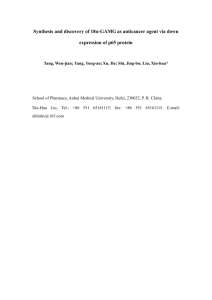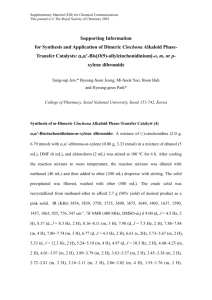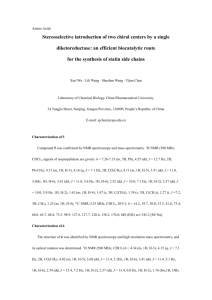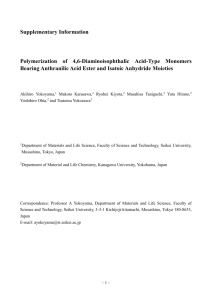Supporting Information
advertisement
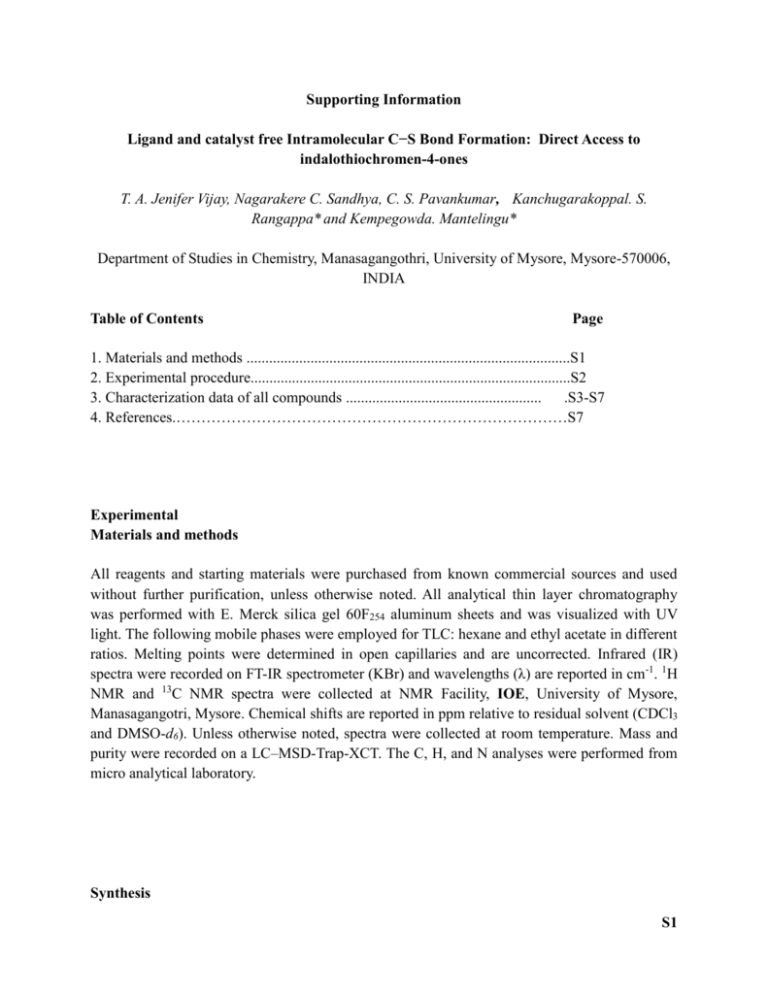
Supporting Information Ligand and catalyst free Intramolecular C−S Bond Formation: Direct Access to indalothiochromen-4-ones T. A. Jenifer Vijay, Nagarakere C. Sandhya, C. S. Pavankumar, Kanchugarakoppal. S. Rangappa* and Kempegowda. Mantelingu* Department of Studies in Chemistry, Manasagangothri, University of Mysore, Mysore-570006, INDIA Table of Contents Page 1. Materials and methods ......................................................................................S1 2. Experimental procedure.....................................................................................S2 3. Characterization data of all compounds .................................................... .S3-S7 4. References.……………………………………………………………………S7 Experimental Materials and methods All reagents and starting materials were purchased from known commercial sources and used without further purification, unless otherwise noted. All analytical thin layer chromatography was performed with E. Merck silica gel 60F254 aluminum sheets and was visualized with UV light. The following mobile phases were employed for TLC: hexane and ethyl acetate in different ratios. Melting points were determined in open capillaries and are uncorrected. Infrared (IR) spectra were recorded on FT-IR spectrometer (KBr) and wavelengths (λ) are reported in cm-1. 1H NMR and 13C NMR spectra were collected at NMR Facility, IOE, University of Mysore, Manasagangotri, Mysore. Chemical shifts are reported in ppm relative to residual solvent (CDCl3 and DMSO-d6). Unless otherwise noted, spectra were collected at room temperature. Mass and purity were recorded on a LC–MSD-Trap-XCT. The C, H, and N analyses were performed from micro analytical laboratory. Synthesis S1 Preparation of 3-Acetyl-2-chloroindole / 3-Acetyl-5-bromo-2-chloroindole B [1]. To a solution of dimethylformamide (10.5 mL, 3eq, in 20 mL dichloromethane) phosphorus oxychloride (11 mL, 3eq, in 20 mL dichloromethane) was added drop wise at 0°C. The reaction mixture was stirred for 15 min, and then 2-oxindole (5g, 1eq, in 20 mL CHCl3) was added in small portions and stirred at reflux for 5h. The reaction was quenched by addition of crushed ice to the media stirring for 20 min and then the two layers were separated. The aqueous layer was adjusted to pH 7 with sodium acetate. The mixture was left at room temperature overnight and then the solid 1-(2-chloro-1H-indol-3-yl)ethanone (B) was collected by filtration, washed with water and dried. Preparation of N-benzyl-3-Acetyl-2-chloroindole 1a [2]. A mixture of 1-(2-chloro-1H-indol-3-yl)ethanone (2.5 g) and potassium hydroxide (1.25g, 1.5 eq) in dry DMF (10 mL) was stirred until soulibilization of KOH. Next, benzyl bromide (1.4 mL, 1.1eq) was added and stirred at room temperature until 3-acetyl-2-chloroindole disappeared (monitored by TLC). After completion of reaction the mixture was poured into water and extracted to ethyl acetate, was dried over sodium sulfate. Solvent was removed and half-white solid was recrystallized with diethyl ether. Preparation of N-methyl-3-Acetyl-2-chloroindole 1b / N-methyl-3-Acetyl-5-bromo -2chloroindole 1c. To a stirred solution of sodium hydride in DMF, 3-acetyl-2-chloroindole or 3-acetyl- 5-bromo-2chloroindole was added. After 15 min, methyl iodide (1eq) was added and stirred until reaction was complete. The reaction mixture was poured to ice-cold water and the precipitated solid was filtered and washed several times. The crude product was recrystallized with diethyl ether. General procedure for one-pot synthesis of indalothiochromen-4-ones 3 (a-o): To a 60% suspension of NaH in mineral oil (2.5 mmol, 2.5 eq, 2 mL in DMF) at 0°C compound 1 (1.0 mmol, 1.0 eq) was added followed by stirring for 10-15 min at room temperature. A solution of dithioester 2 (1.0 mmol, 1.0 eq, 2 mL in DMF) was added over a period of 10 min at 0°C followed by stirring at room temperature for 6-7 h. The completion of the reaction was monitored by TLC. The mixture was poured into water and extracted with ethyl acetate (2 × 25 mL). The combined organic layers were washed with brine (25 mL) and dried over anhydrous sodium sulfate. The solvent was removed under reduced pressure and the crude product was passed through a small plug of silica using hexane/ethyl acetate (8:2) to afford indalothiochromen-4-ones 3(a-o). S2 Characterization Data 9-Benzyl-2-phenylthiopyrano[2,3-b]indol-4(9H)-one (3a): Following the general procedure, compound 3a was obtained from the reaction between 3-acetyl, 1-benzyl, 2-chloro indole (1a) and phenyl dithioester (2a) in 60 % yield as a pale brown solid; mp 164–166 °C; 1H NMR (400 MHz, CDCl3): δ 8.65 (d, J = 4.8 Hz, 1H), 7.60 (t, J = 3.6 Hz, 2H), 7.46–7.45 (m, 3H), 7.38–7.36 (m, 3H), 7.29–7.25 (m, 4H), 7.14 (d, J = 6.4 Hz, 2H), 5.43 (s, 2H); 13C NMR (400 MHz, CDCl3): δ 178.5, 143.9, 142.9, 137.9, 136.5, 134.6, 130.3, 129.0, 127.2, 127.0, 126.6, 124.7, 122.7, 122.4, 114.2, 108.9, 48.2; IR (KBr): 1597, 1481, 1474, 1419, 1334, 873, 750, 743, 717, 612 cm−1; MS (ESI + ion): m/z = 368.1 (M +). Anal. Cacld for C24H17NOS: C, 78.45; H, 4.66; N, 3.81. Found: C, 78.43; H, 4.64; N, 3.79. 9-Benzyl-2-(p-tolyl)thiopyrano[2,3-b]indol-4(9H)-one (3b): Following the general procedure, compound 3b was obtained from the reaction between 3-acetyl, 1benzyl, 2-chloro indole (1a) and dithioester (2b) in 83 % yield as orange color solid; mp 260–262 °C; 1H NMR (400 MHz, DMSO-d6): δ 8.40 (d, J = 7.4 Hz, 1H), 7.78 (d, J = 8.2 Hz, 1H), 7.65 (d, J = 8.2 Hz, 2H), 7.43–7.39 (m, 1H), 7.36–7.30 (m, 5H), 7.27 (d, J = 7.0 Hz, 1H), 7.25–7.21 (m, 2H), 7.20 (s, 1H), 5.71 (s, 2H), 2.36 (s, 3H); 13C NMR (100 MHz, DMSO-d6): δ 177.8, 144.1, 142.6, 141.1, 138.1, 136.0, 133.3, 130.5, 129.3, 128.3, 127.3, 125.7, 125.0, 124.3, 122.5, 121.7, 113.4, 110.7, 48.0, 21.2; IR (KBr): 1597, 1444, 1413, 1365, 1282, 1223, 1145, 1137,1052, 873,793, 610 cm−1; MS (ESI + ion): m/z = 381.9 (M +). Anal. Cacld for C25H19NOS: C, 78.71; H, 5.02; N, 3.67. Found: C, 78.69; H, 5.01; N, 3.65. 9-Benzyl-2-(4-methoxyphenyl)thiopyrano[2,3-b]indol-4(9H)-one (3c): Following the general procedure, compound 3c was obtained from the reaction between 3acetyl, 1-benzyl, 2-chloro indole (1a) and dithioester (2c) in 78 % yield as pale green solid; mp 168–170 °C; 1H NMR (400 MHz, DMSO-d6): δ 8.40 (d, J = 7.6 Hz, 1H), 7.77 (d, J = 8.2 Hz, 1H), 7.71 (d, J = 8.7 Hz, 2H), 7.41 (t, J = 7.2 Hz, 1H), 7.35–7.31 (m, 3H), 7.28– 7.26 (m, 1H), 7.24–7.22 (m, 2H), 7.17 (s, 1H), 5.70 (s, 2H), 3.82 (s, 3H); 13C NMR (100 MHz, DMSO-d6): δ 177.8, 161.6, 143.1, 137.1, 128.8, 127.4, 125.1, 122.1, 115.3, 113.2, 110.6, 55.9, 48.0; IR (KBr): 1598, 1484, 1423, 1315, 1272, 1233, 1185, 1107,1022, 823,743, 602 cm −1; MS (ESI + ion): m/z = 398.7 (M +). Anal. Cacld for C25H19NOS: C, 77.72; H, 4.82; N, 3.94. Found: C, 77.69; H, 4.80; N, 3.91. 9-Benzyl-2-(3,4-dimethoxyphenyl)thiopyrano[2,3-b]indol-4(9H)-one (3d): Following the S3 general procedure, compound 3d was obtained from the reaction between 3-acetyl, 1-benzyl, 2chloro indole (1a) and dithioester (2d) in 62% yield as pale yellow color solid; mp 175–177 °C; 1 H NMR (400 MHz, DMSO-d6): δ 8.39 (d, J = 8.0 Hz, 1H), 7.66 (d, J = 7.6 Hz, 1H), 7.42 (t, J = 6.4 Hz, 2H), 7.44–7.23 (m, 8H), 7.04 (s, 1H), 5.74 (s, 2H), 3.89 (s, 3H), 3.32 (s, 3H); 13C NMR (75.46 MHz, DMSO-d6 ): δ 176.2, 154.1, 144.1, 142.7, 138.1, 136.5, 131.8, 129.3, 128.4, 127.5, 126.2, 125.0, 124.4, 122.6, 121.8, 110.7, 105.1, 60.7, 56.6, 48.0; IR (KBr): 1595, 1498, 1454, 1382, 1333, 1262, 1128, 1108, 870, 767, 610 cm−1; MS (ESI + ion): m/z = 428.4 (M +). Anal. Cacld for C26H21NO3S: C, 73.04; H, 4.95; N, 3.28. Found: C, 73.05; H, 4.94; N, 3.25. 9-Benzyl-2-(3,4,5-trimethoxyphenyl)thiopyrano[2,3-b]indol-4(9H)-one (3e): Following the general procedure, compound 3e was obtained from the reaction between 3-acetyl, 1-benzyl, 2-chloro indole (1a) and dithioester (2e) in 76% yield as pale yellow color solid; mp 169–171 °C; 1H NMR (400 MHz, DMSO-d6): δ 8.43 (d, J = 7.7 Hz, 1H), 7.76 (d, J = 8.1 Hz, 1H), 7.42 (t, J = 7.2 Hz, 1H), 7.44–7.23 (m, 7H), 7.02 (s, 2H), 5.73 (s, 2H), 3.89 (s, 6H), 3.73 (s, 3H); 13C NMR (75.46 MHz, DMSO-d6 ): δ 177.8, 153.8, 144.1, 142.7, 138.1, 136.0, 131.8, 129.3, 128.4, 127. 5, 126.2, 125.0, 124.4, 122.6, 121.8, 110.7, 105.1, 60.6, 56.6, 48.0; IR (KBr): 1599, 1505, 1479, 1420, 1332, 1249, 1126, 1008, 829, 758, 667 cm−1; MS (ESI + ion): m/z = 458.7 (M +). Anal. Cacld for C24H16ClNOS: C, 70.88; H, 5.07; N, 3.06. Found: C, 70.85; H, 5.05; N, 3.05. 9-Benzyl-2-(4-chlorophenyl)thiopyrano[2,3-b]indol-4(9H)-one (3f): Following the general procedure, compound 3f was obtained from the reaction between 3acetyl, 1-benzyl, 2-chloro indole (1a) and dithioester (2f) in 67% yield as orange color solid; mp 210–212 °C; 1H NMR (400 MHz, DMSO-d6): δ 8.41 (d, J = 7.5Hz, 1H), 7.78 (d, J = 8.8 Hz, 3H), 7.61 (d, J = 7.8 Hz, 2H), 7.4 (t, J = 7.2 Hz, 1H), 7.36–7.32 (m, 4H), 7.30 (s, 1H), 7.28–7.22 (m, 2H), 5.70 (s, 2H); 13C NMR (100 MHz, DMSO-d6 ): δ 142.5, 138.1, 135.9, 135.0, 129.9, 129.3, 128.4, 127.4, 126.7, 125.2, 124.2, 122.6, 121.7, 113.4, 110.7; IR (KBr): 1604, 1485, 1482, 1452, 1385, 1189, 1094, 823, 745, 706, 607 cm−1; MS (ESI + ion): m/z = 401.88 (M +). Anal. Cacld for C24H16ClNOS: C, 71.72; H, 4.01; N, 3.49. Found: C, 71.71; H, 4.01; N, 3.47. 9-Benzyl-2-(4-bromophenyl)thiopyrano[2,3-b]indol-4(9H)-one (3g): Following the general procedure, compound 3g was obtained from the reaction between 3acetyl, 1-benzyl, 2-chloro indole (1a) and dithioester (2g) in 61% S4 yield as light orange color solid; mp 213–215 °C; 1H NMR (400 MHz, CDCl3): δ 8.57 (dd, J=7.5, 2.8 Hz, 1H), 7.58 (d, J = 8.4 Hz, 2H), 7.46 (d, J = 8.8 Hz, 2H), 7.40–7.32 (m, 4H), 7.32– 7.25 (m, 3H), 7.14 (d, J = 6.8 Hz, 2H), 5.47 (s, 2H); 13C NMR (100.53 MHz, CDCl3): δ 177.5, 143.7, 138.1, 135.0, 134.2, 132.5, 129.6, 128.7, 125.3, 124.2, 122.8, 113.9, 109.1, 48.4; IR (KBr): 1598, 1484, 1389, 1191,1077, 1008, 821, 751, 725, 697 cm−1; MS (ESI + ion): m/z = 448.6 (M +2). Anal. Cacld for C24H16ClNOS: C, 64.58; H, 3.61; N, 3.14. Found: C, 64.55; H, 3.58; N, 3.12. 9-Benzyl-2-(4-fluorophenyl)thiopyrano[2,3-b]indol-4(9H)-one (3h): Following the general procedure, compound 3h was obtained from the reaction between 3acetyl, 1-benzyl, 2-chloro indole (1a) and dithioester (2h) in 53% yield as cream color solid; mp 155–157°C; 1H NMR (400 MHz, CDCl3): δ 8.59 (d, J = 4.8 Hz, 1H), 7.61–7.57 (m, 2H), 7.42–7.25 (m, 7H), 7.20– 7.13 (m, 4H), 5.47(s, 2H); 13C NMR (100.53 MHz, CDCl3 ): δ 165.3, 162.8, 138.0, 134.3, 132.3, 129.2, 128.3, 126.1, 125.1, 124.3, 122.7, 116.4, 109.0, 48.4; IR (KBr): 1607, 1486, 1452, 1230, 1162, 1107, 1334, 833, 746, 559 cm−1; MS (ESI + ion): m/z = 386.6 (M +). Anal. Cacld for C24H16ClNOS: C, 74.78; H, 4.18; N, 3.63. Found: C, 74.76; H, 4.16; N, 3.62. 9-Benzyl-2-(thiophen-2-yl)thiopyrano[2,3-b]indol-4(9H)-one (3i): Following the general procedure, compound 3i was obtained from the reaction between 3acetyl, 1-benzyl, 2-chloro indole (1a) and dithioester (2i) in 63% yield as light brown solid; mp 207–209 °C; 1H NMR (400 MHz, DMSO-d6): δ 8.38 (d, J = 7.4 Hz, 1H), 7.84 (d, J = 5.02, 1H), 7.77 (d, J = 8.2 Hz, 1H), 7.71 (d, J = 4.52 Hz, 1H), 7.41 (t, J = 7.1 Hz, 1H), 7.35–7.29 (m, 3H), 7.29 (d, J = 8.8 Hz, 1H), 7.26–7.22 (m, 3H), 7.20 (s, 1H), 5.70 (s, 2H); 13C NMR (100 MHz, DMSO-d6 ): δ 177.5, 141.5, 137.9, 135.9, 129.7, 128.0, 125.1, 124.3, 122.2, 113.5, 110.7, 48.0; IR (KBr): 1606, 1520, 1474, 1420, 1275, 1121, 765, 758, 742, 400 cm−1; MS (ESI + ion): m/z = 374.6 (M +). Anal. Cacld for C22H15NOS2: C, 70.75; H, 4.05; N, 3.75. Found: C, 70.73; H, 4.03; N, 3.72. 2-(Benzo[b]thiophen-3-yl)-9-benzylthiopyrano[2,3-b]indol-4(9H)-one (3j): Following the general procedure, compound 3j was obtained from the reaction between 3-acetyl, 1-benzyl, 2-chloro indole (1a) and dithioester (2j) in 56% yield as amber color solid; mp 145–149°C; 1H NMR (399.82 MHz, CDCl3): δ 8.47 (d, J = 7.2 Hz, 1H), 8.01 (d, J = 8.0 Hz, 2H), 7.85–7.75 (m, 4H), 7.42–7.31 (m, 5H), 7.25–7.18 (m, 2H), 7.12 (d, J = 7.6 Hz, 1H), 5.51 (s, 2H); 13 C NMR (100 MHz, CDCl3): δ 182.1, 147.8, 141.1, 137.5, 135.9, 132.1, 129.3, 128.8, 128.6, S5 127.6, 126.6, 125.1, 124.6, 122.5, 122.2, 121.4, 119.8, 112.5, 110.9, 109.9, 60.7; IR (KBr): 1586, 1480, 1424, 1419, 1266, 1117, 755, 752, 733, 401 cm−1; MS (ESI + ion): m/z = 423.8 (M + ). Anal. Cacld for C26H17NOS2: C, 73.73; H, 4.05; N, 3.31. Found: C, 73.72; H, 4.03; N, 3.30. 9-Methyl-2-(p-tolyl)thiopyrano[2,3-b]indol-4(9H)-one (3k): Following the general procedure, compound 3k was obtained from the reaction between 3-acetyl, 2chloro, N-methyl indole (1b) and dithioester (2b) in 58% yield as pale yellow solid; mp 216–218 °C; 1H NMR (399.82 MHz, CDCl3): δ 8.65 (d, J = 8.0 Hz, 1H), 8.44 (d, J = 8.0 Hz, 1H), 7.92–7.84 (m, 2H), 7.58 (d, J = 7.6 Hz, 2H), 7.41–7.23 (m, 3H), 3.94 (s, 3H), 2.41(s, 3H); 13C NMR (100 MHz, CDCl3): δ 177.0, 144.8, 143.3, 141.8, 138.8, 134.0, 130.2, 129.0, 128.1, 127.2, 123.1, 121.5, 113.1, 108.8, 36.6, 21.3; IR (KBr): 3322, 1620, 1468, 1442, 1398, 1119, 1022, 826, 764, 727, 660 cm−1; MS (ESI + ion): m/z = 305.92 (M +). Anal. Cacld for C19H15NOS2: C, 74.72; H, 4.95; N, 4.59. Found: C, 74.72; H, 4.93; N, 4.58. 2-(4-Methoxyphenyl)-9-methylthiopyrano[2,3-b]indol-4(9H)-one (3l): Following the general procedure, compound 3l was obtained from the reaction between 3acetyl, 2-chloro, N-methyl indole (1b) and dithioester (2c) in 51% yield as cream color solid; mp 223–225°C; 1H NMR (399.82 MHz, CDCl3): δ 8.66 (d, J = 7.6 Hz, 1H), 8.09 (d, J = 7.6 Hz, 1H), 7.84– 7.82 (m, 2H), 7.65 (t, J = 8.0 Hz, 2H), 7.39 (d, J = 8.4 Hz, 2H), 7.01 (d, J = 6.0 Hz, 1H), 4.60 (s, 3H), 3.89 (s, 3H); 13C NMR (100 MHz, CDCl3): δ 178.4, 160.1, 147.8, 136.9, 129.1, 128.7, 128.6, 126.6, 123.1, 121.7, 119.7, 114.2, 110.1, 109.9, 55.6, 36.4 ; IR (KBr): 3353, 1605, 1480, 1422, 1389, 1109, 1021, 806, 746, 725, 669 cm−1; MS (ESI + ion): m/z = 321.9 (M +). Anal. Cacld for C19H15NO2S: C, 71.00; H, 4.70; N, 4.36. Found: C, 71.00; H, 4.69; N, 4.34. 9-Methyl-2-(thiophen-2-yl)thiopyrano[2,3-b]indol-4(9H)-one (3m): Following the general procedure, compound 3m was obtained from the reaction between 3acetyl, 2-chloro, N-methyl indole (1b) and dithioester (2i) in 63% yield as bright orange color solid; mp 202–204°C; 1H NMR (399.82 MHz, CDCl3): δ 8.47 (d, J = 6.8 Hz, 1H), 7.76 (d, J = 4.0 Hz, 1H), 7.69 (d, J = 4.8 Hz, 1H), 7.63 (d, J = 8.4 Hz, 1H), 7.42 (dt, J = 7.2, 1.6 Hz, 1H), 7.33(dt, J1 = 7.6, 0.8 Hz, 1H), 7.28–7.25 (m, 1H), 7.15 (s, 1H) 3.99 (s, 3H); 13C NMR (100 MHz, DMSO-d6 ): δ 177.4, 141.8, 138.5, 138.1, 135.9, 130.3, 128.6, 127.7, 125.1, 122.5, 121.1, 113.5, 110.5, 36.7; IR (KBr): 3069, 1592, 1481, 1414, 1333, 1234, 1154, 1106, 1052, 1016, 851, 810, 732,710, 705 cm−1; MS (ESI + ion): m/z = 297.86 (M +). Anal. Cacld for C16H11NOS2: C, 64.62; H, 3.73; N, S6 4.71. Found: C, 64.60; H, 3.72; N, 4.70. 6-Bromo-9-methyl-2-(p-tolyl)thiopyrano[2,3-b]indol-4(9H)-one (3n): Following the general procedure, compound 3n was obtained from the reaction between 3-acetyl, 5-bromo, 2-chloro, N-methyl indole (1c) and dithioester (2b) in 52% yield as pale brown solid; mp 168–170 °C; 1H NMR (399.82 MHz, CDCl3): δ 8.73 (s, 2H), 8.59 (d, J = 6.8 Hz, 1H), 7.41 (dd, J = 6.6, 1.2 Hz, 2H), 7.34–7.29 (m, 2H), 6.94 (d, J = 8.8 Hz, 1H), 3.81(s, 3H), 13 2.12 (s, 3H); C NMR (100 MHz, CDCl3): δ 176.8, 147.9, 138.0, 136.4, 134.8, 129.0, 128.8, 128.7, 126.3, 124.7, 123.5, 121.1, 113.8, 111.8, 110.2, 36.6, 21.3; IR (KBr): 1594, 1480, 1424, 1363,1234, 1194, 1052, 1016, 851, 810, 732, 705 cm−1; MS (ESI + ion): m/z = 322.12 (M +). Anal. Cacld for C19H14BrNOS: C, 59.38; H, 3.67; N, 3.64. Found: C, 59.36; H, 3.66; N, 3.63. 6-Bromo-2-(4-methoxyphenyl)-9-methylthiopyrano[2,3-b]indol-4(9H)-one (3o): Following the general procedure, compound 3o was obtained from the reaction between 3-acetyl, 5-bromo, 2-chloro, N-methyl indole (1c) and dithioester (2c) in 48% yield as pale yellow solid; mp 218–220 °C; 1 H NMR (399.82 MHz, CDCl3): δ 8.30 (d, J = 8.8 Hz, 1H), 8.17 (d, J = 8.8 Hz, 1H), 8.07–8.03 (m, 3H), 6.99–6.95 (m, 2H), 6.91 (s, 1H), 3.88 (s, 3H), 3.87 (s, 3H); 13 C NMR (100 MHz, CDCl3): δ 177.1, 160.0, 147.1, 134.5, 129.1, 128.8, 128.7, 128.3, 124.5, 123.3, 121.0, 114.2, 113.1, 110.7, 110.2, 48.8, 36.6; IR (KBr): 1617, 1490, 1439, 1372, 1238, 1199, 1025, 969, 902, 747, 642 cm−1; MS (ESI + ion): m/z = 399.1 (M +). Anal. Cacld for C19H14BrNO2S: C, 57.01; H, 3.53; N, 3.50. Found: C, 57.00; H, 3.51; N, 3.49 References [1] Monge,A.; Palop,J.; Ramirez,C.; Font,M.; Fernandez-Alvarez,E. New 5H-1,2,4-triazino[5,6b]indole and aminoindole derivatives. Synthesis and studies as inhibitors of blood platelet aggregation, anti-hypertensive agents and thromboxane synthetase inhibitors. Eur. J. Med. Chem., 1991, 26, 179–88. [2] Corbel,B.; Michaud,F.; Meijer,L.; et al. Towards the syntheses of N -H and N -alkylated derivatives of meridianins. J. Heterocycl. Chem., 2007, 44, 793–801. S7



